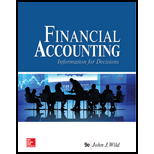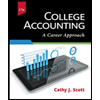
Concept explainers
1.
Introduction: Accounts receivable are legitimately enforceable returns or payments that the organization will get from its clients who have bought its merchandise and services on credit. It is merely a promise to repay the vendor.
To calculate: Estimated balance of allowance for uncollectible.
2.
Introduction: Accounts receivable are legitimately enforceable returns or payments that the organization will get from its clients who have bought its merchandise and services on credit. It is merely a promise to repay the vendor.
Bad debt is an amount that a company fails to receive when the debtors or become insolvent.
To prepare:
3.
Introduction: Accounts receivable are legitimately enforceable returns or payments that the organization will get from its clients who have bought its merchandise and services on credit. It is merely a promise to repay the vendor.
Bad debt is an amount that a company fails to receive when the debtors or become insolvent.
To state: The effect of bad debts on net income in 2019.
Want to see the full answer?
Check out a sample textbook solution
Chapter 7 Solutions
Financial Accounting: Information for Decisions
- On December 31, calculated the payroll, which indicates gross earnings for wages ($460,000), payroll deductions for income tax ($48,000), payroll deductions for FICA ($40,000), payroll deductions for United Way ($6,000), employer contributions for FICA (matching), and state and federal unemployment taxes ($4,000). Employees were paid in cash, but payments for the corresponding payroll deductions have not been made and employer taxes have not yet been recorded. Collected rent revenue of $2,100 on December 10 for office space that Sandler rented to another business. The rent collected was for 30 days from December 12 to January 10 and was credited in full to Deferred Revenue. Required: 1. & 2. Prepare the entries required on December 31 to record payroll, the collection of rent on December 10 and adjusting journal entry on December 31. 3. Show how any liabilities related to these items should be reported on the company’s balance sheet at December 31arrow_forwardBrihteres problem i have to need answer.arrow_forwardSolve it by using proper methodarrow_forward
- Jbl company problem sopve it.arrow_forwardHow much intrest bank collect?arrow_forwardRequired information Skip to question [The following information applies to the questions displayed below.]XYZ declared a $1 per share dividend on August 15. The date of record for the dividend was September 1 (the stock began selling ex-dividend on September 2). The dividend was paid on September 10. Ellis is a cash-method taxpayer. Determine if he must include the dividends in gross income under the following independent circumstances. b. Ellis bought 100 shares of XYZ stock on August 1 for $21 per share. Ellis sold his XYZ shares on September 5 for $23 per share. Ellis received the $100 dividend on September 10 (note that even though Ellis didn’t own the stock on September 10, he still received the dividend because he was the shareholder on the record date).arrow_forward
 Intermediate Accounting: Reporting And AnalysisAccountingISBN:9781337788281Author:James M. Wahlen, Jefferson P. Jones, Donald PagachPublisher:Cengage LearningPrinciples of Accounting Volume 1AccountingISBN:9781947172685Author:OpenStaxPublisher:OpenStax College
Intermediate Accounting: Reporting And AnalysisAccountingISBN:9781337788281Author:James M. Wahlen, Jefferson P. Jones, Donald PagachPublisher:Cengage LearningPrinciples of Accounting Volume 1AccountingISBN:9781947172685Author:OpenStaxPublisher:OpenStax College Cornerstones of Financial AccountingAccountingISBN:9781337690881Author:Jay Rich, Jeff JonesPublisher:Cengage Learning
Cornerstones of Financial AccountingAccountingISBN:9781337690881Author:Jay Rich, Jeff JonesPublisher:Cengage Learning Financial AccountingAccountingISBN:9781305088436Author:Carl Warren, Jim Reeve, Jonathan DuchacPublisher:Cengage Learning
Financial AccountingAccountingISBN:9781305088436Author:Carl Warren, Jim Reeve, Jonathan DuchacPublisher:Cengage Learning College Accounting, Chapters 1-27AccountingISBN:9781337794756Author:HEINTZ, James A.Publisher:Cengage Learning,
College Accounting, Chapters 1-27AccountingISBN:9781337794756Author:HEINTZ, James A.Publisher:Cengage Learning, College Accounting (Book Only): A Career ApproachAccountingISBN:9781337280570Author:Scott, Cathy J.Publisher:South-Western College Pub
College Accounting (Book Only): A Career ApproachAccountingISBN:9781337280570Author:Scott, Cathy J.Publisher:South-Western College Pub





